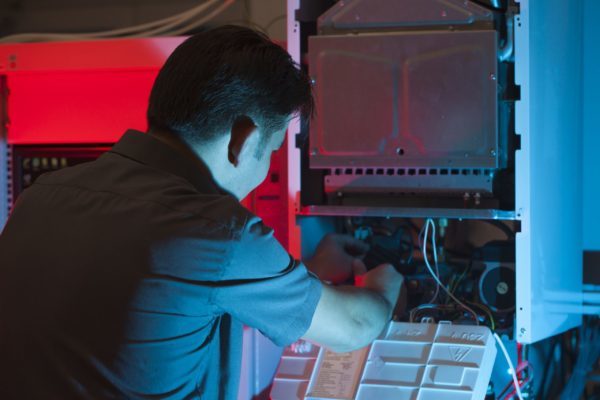
Both boilers and furnaces can be excellent options for heating your home during the winter. However, these units work in two completely different ways and provide different types of heating. Keep reading to learn about the differences between furnaces and boilers and how each type of unit works.
Forced Air vs. Radiant Heating
Furnaces work with a forced-air heating system, which heats the air inside the building. Boilers, on the other hand, are used to provide radiant heating. The boiler supplies hot water or sometimes steam to either radiators or under-floor heating. The hot water heats the floor or the surfaces around the radiator, and this heat then filters out into the air.
Radiant heating has been around for thousands of years and was used to heat buildings in Ancient Rome. You will still often find radiant heating in older US homes. However, the vast majority of buildings in this country rely on a furnace and forced-air heating, unlike Europe and Asia where somewhere between 50 and 80% of buildings have radiant heating systems. That being said, it is not uncommon nowadays to find newer homes that have both forced air and radiant heating systems. In most cases, the furnace is used as the primary heating source, and then a smaller boiler is used to provide under-floor radiant heating in the bathrooms and possibly bedrooms.
The reason that radiant heating isn’t very popular in the US is somewhat of a mystery, as this type of system is generally much more energy efficient than forced-air heating. In most cases, a radiant heating system will use around 25% less energy than a forced-air system while still keeping the building warm just as effectively.
Switching from forced air to a radiant heating system or vice versa is generally never done as it would require a major retrofit and quite extensive construction. However, if you are planning on building a new home, it is definitely worth considering the pros and cons of each type of system to determine which you think is the better fit.
How a Furnace Works
Most furnaces are gas units. You can also find electric units, but these are mostly only used in places with milder winter weather as they are neither very efficient nor all that effective. A gas furnace burns either natural gas or propane to create heat. Burning gas produces extremely hot combustion fumes, which travel out of the combustion chamber and flow through a metal heat exchanger. The metal absorbs most of the heat from the fumes as they pass through the heat exchanger, and then the fumes are vented outside through the exhaust flue.
The furnace works in conjunction with a blower fan to heat air and circulate this hot air throughout the building via a ductwork system. The blower fan brings cold air in and blows it over the heat exchanger. Since the air is colder than the metal heat exchanger, most of the heat energy in the exchanger is released and raises the temperature of the air.
How Boilers Work
A boiler is similar to a water heater because it uses gas or electricity to heat water. However, traditional boilers are not directly connected to the plumbing system in the same way and do not provide potable hot water. There is a pipe that brings cold water into the boiler when it needs to be refilled, but otherwise, the radiant heating system is a closed loop.
Traditional gas boilers have a large burner that is used to heat the water inside the unit’s hot water tank. Electric boilers use an electric resistance coil that heats the water in the tank. Most boilers heat the water to around 190 degrees, but some units raise the temperature to the point where the water actually boils to produce steam.
The hot water or steam is pumped out of the boiler and then flows to all of the radiators in the building or through a series of plastic pipes that run underneath the floor. This causes either the boiler or the floor to become quite hot, which in turn heats the walls, furniture and other nearby surfaces. Finally, the water flows back to the cold-water tank in the boiler, which then feeds back into the hot water tank.
There is also a more advanced type of boiler known as a combination or combi-boiler. These units are similar to a tankless water heater in that they don’t have a hot water storage tank and instead only heat water when needed. This type of unit can be used to provide hot water for both radiant heating and plumbing. The radiant heating system is still a closed loop that runs from the boiler to the radiators or underfloor heating and then back to the boiler, but there is also a hot water pipe running out from the boiler that feeds all of your plumbing fixtures.
At IBBOTSON Heating & Air Conditioning Co., we install and service all types of heating systems, including both furnaces and boilers. We also specialize in the full range of cooling services as well as indoor air quality and water heater services. Give IBBOTSON Heating & Air Conditioning Co. a call today if you have any questions or need to schedule any heating service in the Arlington Heights area.
